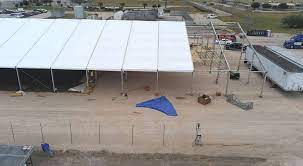Temporary Building


In the fast-paced world of urban development and construction, temporary buildings have emerged as agile and innovative solutions, redefining the traditional notions of architectural permanence. These versatile structures, designed to be assembled and disassembled with ease, offer a dynamic approach to meeting the evolving needs of modern societies. From emergency response shelters to pop-up retail spaces, temporary buildings have carved a niche for themselves in the landscape of urban design, embodying the perfect blend of functionality, flexibility, and sustainability.
The allure of temporary buildings lies in their adaptability to diverse applications and contexts. In times of crisis, such as natural disasters or humanitarian emergencies, temporary structures provide rapid relief and shelter for displaced communities. These makeshift shelters, designed for quick assembly and disassembly, offer a lifeline to those in need, enabling them to rebuild their lives amidst adversity. Moreover, as the world grapples with the challenges of climate change and rising sea levels, temporary buildings have garnered attention as sustainable options for flood- prone areas, providing a resilient and cost-effective solution to mitigate damage and disruption.
Beyond emergency response, temporary buildings have become a fixture in the world of event management and hospitality. From music festivals to sports events, these structures offer an efficient and temporary solution for accommodating large crowds. Temporary event venues boast impressive designs, rivalling traditional structures in both aesthetics and functionality. With the ability to customize layouts and configurations, event organisers can create unique and immersive experiences that leave a lasting impact on attendees.
In the realm of retail and commerce, temporary buildings have breathed new life into the concept of pop-up shops. Brands and entrepreneurs have embraced this trend to test new markets, build buzz around product launches, or capitalise on seasonal opportunities. The transient nature of pop-up stores allows for agility in retail strategies, enabling businesses to stay relevant and responsive to ever-changing consumer demands. Moreover, the lower overhead costs associated with temporary buildings make them an attractive option for startups and small businesses seeking a cost-effective entry into the retail landscape.
In the context of construction and infrastructure projects, temporary buildings have demonstrated their value as efficient site offices and accommodation facilities for workers. These structures can be quickly assembled on project sites, providing comfortable and functional spaces for project management and coordination. As projects conclude, the ease of dismantling temporary buildings minimises the environmental impact, leaving behind little trace of their temporary existence.
While temporary buildings have earned accolades for their flexibility and innovation, they are not without their challenges. Ensuring the safety and durability of temporary structures is paramount, particularly in adverse weather or high-traffic environments. Rigorous engineering standards and adherence to building codes are crucial to guaranteeing the structural integrity of temporary buildings and safeguarding the occupants within.
In the pursuit of sustainable development, temporary buildings offer an environmentally conscious alternative to traditional construction practices. Their modularity and adaptability contribute to reduced waste generation, as these structures can be repurposed or reused in multiple projects. Moreover, the use of eco-friendly materials and renewable energy sources further enhances the sustainability credentials of temporary buildings.
In conclusion, temporary buildings have transcended their fleeting nature to become a pivotal force in modern urban design and development. From emergency shelters that provide hope in times of crisis to pop-up shops that inject excitement into retail landscapes, these structures embody the spirit of adaptability and innovation. As the world continues to grapple with an ever- changing landscape of challenges and opportunities, the versatility of temporary buildings serves as a testament to the resilience and ingenuity of contemporary architecture. Whether for emergency response, event management, retail ventures, or construction projects, temporary buildings offer a blueprint for sustainable, flexible, and practical solutions in an ever-evolving urban environment. To find out more, you can visit Mar-Key Group.




